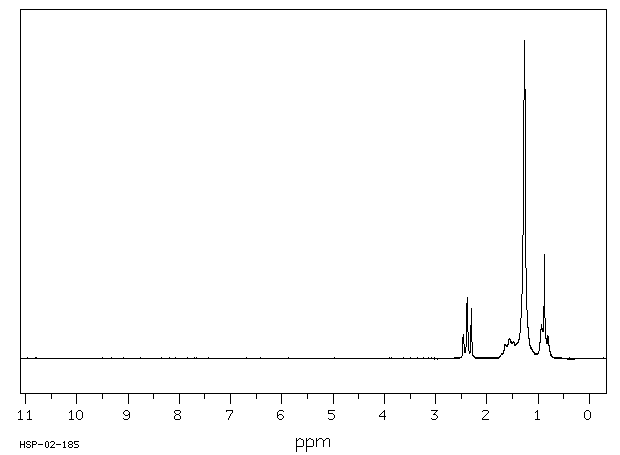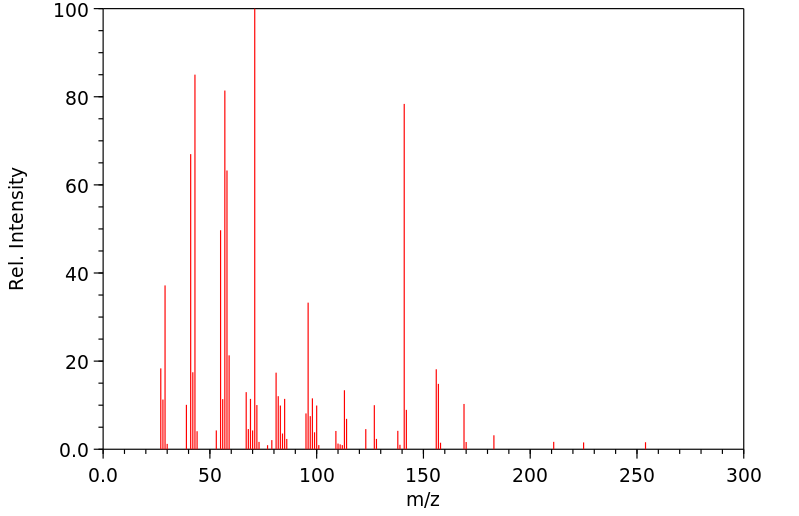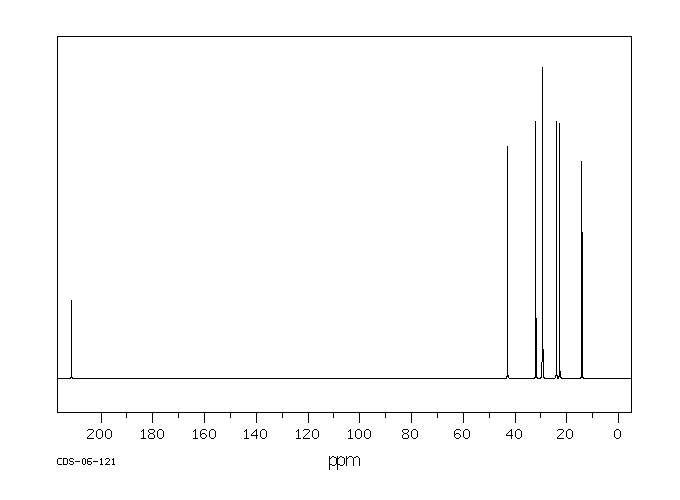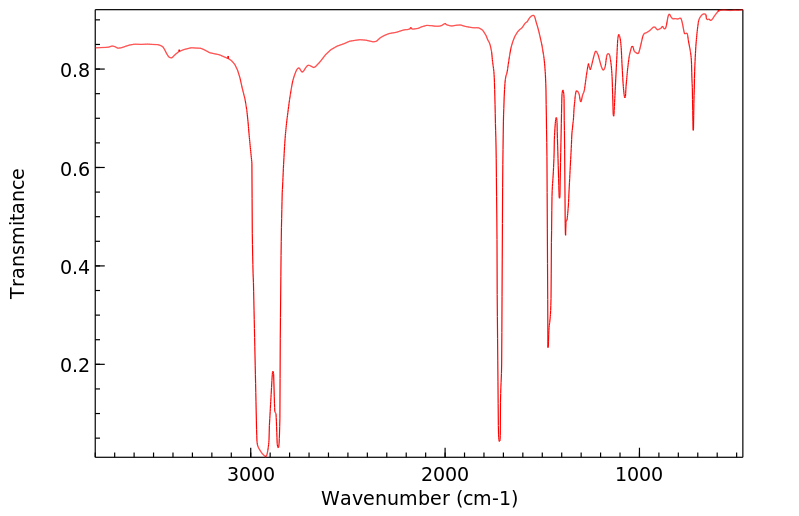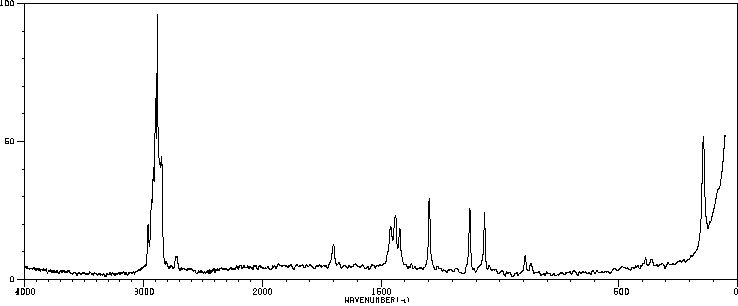9-十七酮 | 540-08-9
中文名称
9-十七酮
中文别名
二辛基酮
英文名称
heptadecan-9-one
英文别名
9-heptadecanone;dioctylketone;bis-octyl ketone
CAS
540-08-9
化学式
C17H34O
mdl
——
分子量
254.456
InChiKey
WTJKUFMLQFLJOT-UHFFFAOYSA-N
BEILSTEIN
——
EINECS
——
-
物化性质
-
计算性质
-
ADMET
-
安全信息
-
SDS
-
制备方法与用途
-
上下游信息
-
文献信息
-
表征谱图
-
同类化合物
-
相关功能分类
-
相关结构分类
物化性质
-
熔点:51-53°C
-
沸点:250-253°C
-
密度:0.8381 (estimate)
-
闪点:250-253°C
-
溶解度:可溶于氯仿(少许)、甲醇(少许)
-
LogP:7.280 (est)
-
保留指数:1846;1846;1866;1860.8
-
稳定性/保质期:
按规格使用和贮存,不会发生分解,避免与氧化物接触。
计算性质
-
辛醇/水分配系数(LogP):7
-
重原子数:18
-
可旋转键数:14
-
环数:0.0
-
sp3杂化的碳原子比例:0.94
-
拓扑面积:17.1
-
氢给体数:0
-
氢受体数:1
安全信息
-
海关编码:2914190090
-
安全说明:S22,S24/25
-
危险性防范说明:P261,P305+P351+P338
-
危险性描述:H302,H315,H319,H335
-
储存条件:储存于阴凉、干燥、通风良好的库房。远离火种和热源,防止阳光直射,包装需密封。应与酸类及食用化学品分开存放,切忌混储。储区应备有合适的材料以收容泄漏物。
SDS
9-十七酮 修改号码:5
模块 1. 化学品
产品名称: 9-Heptadecanone
修改号码: 5
模块 2. 危险性概述
GHS分类
物理性危害 未分类
健康危害 未分类
环境危害 未分类
GHS标签元素
图标或危害标志 无
信号词 无信号词
危险描述 无
防范说明 无
模块 3. 成分/组成信息
单一物质/混和物 单一物质
化学名(中文名): 9-十七酮
百分比: >98.0%(GC)
CAS编码: 540-08-9
俗名: Di-n-octyl Ketone , Pelargone
分子式: C17H34O
模块 4. 急救措施
吸入: 将受害者移到新鲜空气处,保持呼吸通畅,休息。若感不适请求医/就诊。
皮肤接触: 立即去除/脱掉所有被污染的衣物。用水清洗皮肤/淋浴。
若皮肤刺激或发生皮疹:求医/就诊。
眼睛接触: 用水小心清洗几分钟。如果方便,易操作,摘除隐形眼镜。继续清洗。
如果眼睛刺激:求医/就诊。
食入: 若感不适,求医/就诊。漱口。
紧急救助者的防护: 救援者需要穿戴个人防护用品,比如橡胶手套和气密性护目镜。
模块 5. 消防措施
合适的灭火剂: 干粉,泡沫,雾状水,二氧化碳
9-十七酮 修改号码:5
模块 5. 消防措施
特定方法: 从上风处灭火,根据周围环境选择合适的灭火方法。
非相关人员应该撤离至安全地方。
周围一旦着火:如果安全,移去可移动容器。
消防员的特殊防护用具: 灭火时,一定要穿戴个人防护用品。
模块 6. 泄漏应急处理
个人防护措施,防护用具, 使用个人防护用品。远离溢出物/泄露处并处在上风处。
紧急措施: 泄露区应该用安全带等圈起来,控制非相关人员进入。
环保措施: 防止进入下水道。
控制和清洗的方法和材料: 清扫收集粉尘,封入密闭容器。注意切勿分散。附着物或收集物应该立即根据合适的
法律法规处置。
模块 7. 操作处置与储存
处理
技术措施: 在通风良好处进行处理。穿戴合适的防护用具。防止粉尘扩散。处理后彻底清洗双手
和脸。
注意事项: 如果粉尘或浮质产生,使用局部排气。
操作处置注意事项: 避免接触皮肤、眼睛和衣物。
贮存
储存条件: 保持容器密闭。存放于凉爽、阴暗处。
远离不相容的材料比如氧化剂存放。
包装材料: 依据法律。
模块 8. 接触控制和个体防护
工程控制: 尽可能安装封闭体系或局部排风系统,操作人员切勿直接接触。同时安装淋浴器和洗
眼器。
个人防护用品
呼吸系统防护: 防尘面具。依据当地和政府法规。
手部防护: 防护手套。
眼睛防护: 安全防护镜。如果情况需要,佩戴面具。
皮肤和身体防护: 防护服。如果情况需要,穿戴防护靴。
模块 9. 理化特性
固体
外形(20°C):
外观: 晶体-粉末
颜色: 白色-极淡的黄色
气味: 无资料
pH: 无数据资料
熔点:
54°C
沸点/沸程 无资料
闪点: 无资料
爆炸特性
爆炸下限: 无资料
爆炸上限: 无资料
密度: 无资料
溶解度:
[水] 无资料
[其他溶剂]
溶于: 苯
9-十七酮 修改号码:5
模块 10. 稳定性和反应性
化学稳定性: 一般情况下稳定。
危险反应的可能性: 未报道特殊反应性。
须避免接触的物质 氧化剂
危险的分解产物: 一氧化碳, 二氧化碳
模块 11. 毒理学信息
急性毒性: ivn-mus LDLo:10 g/kg
对皮肤腐蚀或刺激: 无资料
对眼睛严重损害或刺激: 无资料
生殖细胞变异原性: 无资料
致癌性:
IARC = 无资料
NTP = 无资料
生殖毒性: 无资料
RTECS 号码: MI3925000
模块 12. 生态学信息
生态毒性:
鱼类: 无资料
甲壳类: 无资料
藻类: 无资料
残留性 / 降解性: 无资料
潜在生物累积 (BCF): 无资料
土壤中移动性
log水分配系数: 无资料
土壤吸收系数 (Koc): 无资料
亨利定律 无资料
constaNT(PaM3/mol):
模块 13. 废弃处置
如果可能,回收处理。请咨询当地管理部门。建议在可燃溶剂中溶解混合,在装有后燃和洗涤装置的化学焚烧炉中
焚烧。废弃处置时请遵守国家、地区和当地的所有法规。
模块 14. 运输信息
联合国分类: 与联合国分类标准不一致
UN编号: 未列明
模块 15. 法规信息
《危险化学品安全管理条例》(2002年1月26日国务院发布,2011年2月16日修订): 针对危险化学品的安全使用、
生产、储存、运输、装卸等方面均作了相应的规定。
9-十七酮 修改号码:5
模块16 - 其他信息
N/A
模块 1. 化学品
产品名称: 9-Heptadecanone
修改号码: 5
模块 2. 危险性概述
GHS分类
物理性危害 未分类
健康危害 未分类
环境危害 未分类
GHS标签元素
图标或危害标志 无
信号词 无信号词
危险描述 无
防范说明 无
模块 3. 成分/组成信息
单一物质/混和物 单一物质
化学名(中文名): 9-十七酮
百分比: >98.0%(GC)
CAS编码: 540-08-9
俗名: Di-n-octyl Ketone , Pelargone
分子式: C17H34O
模块 4. 急救措施
吸入: 将受害者移到新鲜空气处,保持呼吸通畅,休息。若感不适请求医/就诊。
皮肤接触: 立即去除/脱掉所有被污染的衣物。用水清洗皮肤/淋浴。
若皮肤刺激或发生皮疹:求医/就诊。
眼睛接触: 用水小心清洗几分钟。如果方便,易操作,摘除隐形眼镜。继续清洗。
如果眼睛刺激:求医/就诊。
食入: 若感不适,求医/就诊。漱口。
紧急救助者的防护: 救援者需要穿戴个人防护用品,比如橡胶手套和气密性护目镜。
模块 5. 消防措施
合适的灭火剂: 干粉,泡沫,雾状水,二氧化碳
9-十七酮 修改号码:5
模块 5. 消防措施
特定方法: 从上风处灭火,根据周围环境选择合适的灭火方法。
非相关人员应该撤离至安全地方。
周围一旦着火:如果安全,移去可移动容器。
消防员的特殊防护用具: 灭火时,一定要穿戴个人防护用品。
模块 6. 泄漏应急处理
个人防护措施,防护用具, 使用个人防护用品。远离溢出物/泄露处并处在上风处。
紧急措施: 泄露区应该用安全带等圈起来,控制非相关人员进入。
环保措施: 防止进入下水道。
控制和清洗的方法和材料: 清扫收集粉尘,封入密闭容器。注意切勿分散。附着物或收集物应该立即根据合适的
法律法规处置。
模块 7. 操作处置与储存
处理
技术措施: 在通风良好处进行处理。穿戴合适的防护用具。防止粉尘扩散。处理后彻底清洗双手
和脸。
注意事项: 如果粉尘或浮质产生,使用局部排气。
操作处置注意事项: 避免接触皮肤、眼睛和衣物。
贮存
储存条件: 保持容器密闭。存放于凉爽、阴暗处。
远离不相容的材料比如氧化剂存放。
包装材料: 依据法律。
模块 8. 接触控制和个体防护
工程控制: 尽可能安装封闭体系或局部排风系统,操作人员切勿直接接触。同时安装淋浴器和洗
眼器。
个人防护用品
呼吸系统防护: 防尘面具。依据当地和政府法规。
手部防护: 防护手套。
眼睛防护: 安全防护镜。如果情况需要,佩戴面具。
皮肤和身体防护: 防护服。如果情况需要,穿戴防护靴。
模块 9. 理化特性
固体
外形(20°C):
外观: 晶体-粉末
颜色: 白色-极淡的黄色
气味: 无资料
pH: 无数据资料
熔点:
54°C
沸点/沸程 无资料
闪点: 无资料
爆炸特性
爆炸下限: 无资料
爆炸上限: 无资料
密度: 无资料
溶解度:
[水] 无资料
[其他溶剂]
溶于: 苯
9-十七酮 修改号码:5
模块 10. 稳定性和反应性
化学稳定性: 一般情况下稳定。
危险反应的可能性: 未报道特殊反应性。
须避免接触的物质 氧化剂
危险的分解产物: 一氧化碳, 二氧化碳
模块 11. 毒理学信息
急性毒性: ivn-mus LDLo:10 g/kg
对皮肤腐蚀或刺激: 无资料
对眼睛严重损害或刺激: 无资料
生殖细胞变异原性: 无资料
致癌性:
IARC = 无资料
NTP = 无资料
生殖毒性: 无资料
RTECS 号码: MI3925000
模块 12. 生态学信息
生态毒性:
鱼类: 无资料
甲壳类: 无资料
藻类: 无资料
残留性 / 降解性: 无资料
潜在生物累积 (BCF): 无资料
土壤中移动性
log水分配系数: 无资料
土壤吸收系数 (Koc): 无资料
亨利定律 无资料
constaNT(PaM3/mol):
模块 13. 废弃处置
如果可能,回收处理。请咨询当地管理部门。建议在可燃溶剂中溶解混合,在装有后燃和洗涤装置的化学焚烧炉中
焚烧。废弃处置时请遵守国家、地区和当地的所有法规。
模块 14. 运输信息
联合国分类: 与联合国分类标准不一致
UN编号: 未列明
模块 15. 法规信息
《危险化学品安全管理条例》(2002年1月26日国务院发布,2011年2月16日修订): 针对危险化学品的安全使用、
生产、储存、运输、装卸等方面均作了相应的规定。
9-十七酮 修改号码:5
模块16 - 其他信息
N/A
制备方法与用途
合成制备方法
暂无相关信息
用途暂无相关信息
上下游信息
反应信息
-
作为反应物:描述:9-十七酮 在 N-溴代丁二酰亚胺(NBS) 、 对甲苯磺酸 作用下, 以 N,N-二甲基甲酰胺 、 甲苯 为溶剂, 生成 5,6-dibromo-2,2-dioctyl-1,3-benzodioxole参考文献:名称:具有平面外烷基取代基的新型酞菁的自序性质。摘要:由2,2-二烷基茚满和2,2-二烷基-1,3-苯并二恶唑前体制备了两个新颖的酞菁系列同源物。预期将烷基链连接到与酞菁环的外围位点融合的五元环上,将导致采用面外构型,从而阻止界面聚集,从而提供与纠察栅栏的类比卟啉。该策略被证明部分成功。衍生自2,2-二烷基-1,3-苯并二恶唑的酞菁系列的某些成员(其中烷基链通过环状缩酮连接到酞菁上)形成了旋涂薄膜,其中酞菁芯完全隔离。此行为与无序晶体的形成有关,该无序晶体在这些材料的热曲线中以中间相的形式出现。然而,衍生自2,2-二烷基茚满的酞菁在宽的温度范围内显示出柱状中间相,并且在环境温度下具有一些液晶衍生物。该系列的辛己基衍生物的单晶X射线衍射结构显示了柱状组件如何通过使酞菁组分的大环平面相对于色谱柱的轴倾斜来容纳平面外烷基链。这项研究有助于强调取代基的空间和电子效应对酞菁在缩合相中的堆积行为的重要性,尤其是直接与环相连的供电子氧原子的作用。与一些液晶DOI:10.1002/chem.200600697
-
作为产物:参考文献:名称:Synthesis of deuterium-labelled polyoctylalkanes摘要:使用选择性和特定氘标记方法,成功合成了特定标记的9-d-9-辛基十七烷(1)和9-d-9,10-二辛基十八烷(2)。后者的前体四辛基乙烯是通过改进近期发表方法的麦柯里反应变体合成的。DOI:10.1002/jlcr.2580361211
文献信息
-
Carbonylation of R2BI in the presence of NaCo(CO)4 and Na2Fe(CO)4: A simple synthesis of dialkyl ketones作者:A. Devasagayaraj、M.Lakshmi Narayana Rao、M. PeriasamyDOI:10.1016/0022-328x(91)86398-a日期:1991.12Reaction of NaCO(CO)4 with R2BI under carbon monoxide at atmospheric pressure at room temperature readily gives the dialkyl ketones in good yields (61–85%) after H2O2/OH− oxidation.纳科(CO)的反应4其中R 2一氧化碳下BI在大气压力下在室温下很容易地使后的H良好的产率(61-85%)的二烷基酮2 ö 2 / OH -氧化。
-
[EN] LIPIDS AND LIPID COMPOSITIONS FOR THE DELIVERY OF ACTIVE AGENTS<br/>[FR] LIPIDES ET COMPOSITIONS LIPIDIQUES DESTINÉS À LA LIBÉRATION D'AGENTS ACTIFS申请人:NOVARTIS AG公开号:WO2015095346A1公开(公告)日:2015-06-25This invention provides for a compound of formula (I) or a pharmaceutically acceptable salt thereof, wherein R1-R3, n, p, L1 and L2 are defined herein. The compounds of formula (I) and pharmaceutically acceptable salts thereof are cationic lipids useful in the delivery of biologically active agents to cells and tissues.
-
[EN] LIPIDS AND LIPID COMPOSITIONS FOR THE DELIVERY OF ACTIVE AGENTS<br/>[FR] LIPIDES ET COMPOSITIONS LIPIDIQUES POUR L'ADMINISTRATION DE PRINCIPES ACTIFS申请人:NOVARTIS AG公开号:WO2014136086A1公开(公告)日:2014-09-12This invention provides for a compound of formula (I): or a pharmaceutically acceptable salt thereof, wherein R1–R4, L and X are defined herein. The compounds of formula (I) and pharmaceutically acceptable salts thereof are cationic lipids useful in the delivery of biologically active agents to cells and tissues.这项发明提供了一个式(I)的化合物,或其药用可接受的盐,其中R1-R4、L和X在此处被定义。式(I)的化合物及其药用可接受的盐是在将生物活性剂传递给细胞和组织中时有用的阳离子脂质。
-
IONIZABLE CATIONIC LIPID FOR RNA DELIVERY申请人:Arcturus Therapeutics, Inc.公开号:US20180169268A1公开(公告)日:2018-06-21What is described is a compound of formula I consisting of a compound in which R 1 is a branched chain alkyl consisting of 10 to 31 carbons; R 2 is a linear alkyl, alkenyl, or alkynyl consisting of 2 to 20 carbons; L 1 and L 2 are the same or different, each a linear alkylene of 1 to 20 carbons or a linear alkenylene of 2 to 20 carbons; X 1 is S or O; R 3 is a linear or branched alkylene consisting of 1 to 6 carbons; and R 4 and R 5 are the same or different, each a hydrogen or a linear or branched alkyl consisting of 1 to 6 carbons; or a pharmaceutically acceptable salt thereof.
-
From Alkyl Halides to Ketones: Nickel‐Catalyzed Reductive Carbonylation Utilizing Ethyl Chloroformate as the Carbonyl Source作者:Renyi Shi、Xile HuDOI:10.1002/anie.201903330日期:2019.5.27remains in high demand. Described here is a nickel‐catalyzed three‐component reductive carbonylation method for the synthesis of dialkyl ketones. A wide range of both symmetric and asymmetric dialkyl ketones can be accessed from alkyl halides and a safe CO source, ethyl chloroformate. The approach offers complementary substrate scope to existing carbonylation methods while avoiding the use of either toxic
表征谱图
-
氢谱1HNMR
-
质谱MS
-
碳谱13CNMR
-
红外IR
-
拉曼Raman
-
峰位数据
-
峰位匹配
-
表征信息
同类化合物
(反式)-4-壬烯醛
(s)-2,3-二羟基丙酸甲酯
([1-(甲氧基甲基)-1H-1,2,4-三唑-5-基](苯基)甲酮)
(Z)-4-辛烯醛
(S)-氨基甲酸酯β-D-O-葡糖醛酸
(S)-3-(((2,2-二氟-1-羟基-7-(甲基磺酰基)-2,3-二氢-1H-茚满-4-基)氧基)-5-氟苄腈
(R)-氨基甲酸酯β-D-O-葡糖醛酸
(5,5-二甲基-2-(哌啶-2-基)环己烷-1,3-二酮)
(2,5-二氟苯基)-4-哌啶基-甲酮
龙胆苦苷
龙胆二糖甲乙酮氰醇(P)
龙胆二糖丙酮氰醇(P)
龙胆三糖
龙涎酮
齐罗硅酮
齐留通beta-D-葡糖苷酸
鼠李糖
黑芥子苷单钾盐
黑海棉酸钠盐
黑木金合欢素
黑曲霉三糖
黑介子苷
黄尿酸8-O-葡糖苷
麻西那霉素II
麦迪霉素
麦芽糖脎
麦芽糖基海藻糖
麦芽糖1-磷酸酯
麦芽糖
麦芽四糖醇
麦芽四糖
麦芽十糖
麦芽六糖
麦芽五糖水合物
麦芽五糖
麦芽五糖
麦芽五糖
麦芽三糖醇
麦芽三糖
麦芽三糖
麦芽三塘水合
麦芽七糖水合物
麦芽七糖
麦法朵
麦可酚酸-酰基-Β-D-葡糖苷酸
麦利查咪
麝香酮
鹤草酚
鸢尾酚酮 3-C-beta-D-吡喃葡萄糖苷
鸡矢藤苷


